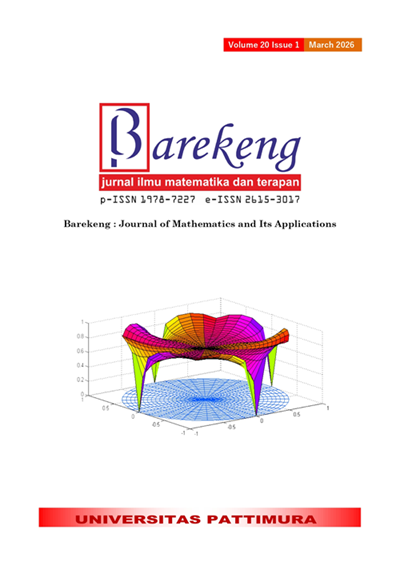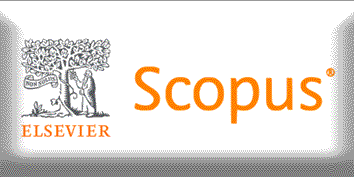THE APPLICATION OF FUZZY LOGIC IN CLUSTERING PROVINCES BASED ON SOCIAL WELFARE, ECONOMIC STATUS, AND HEALTHCARE FACILITIES
Abstract
Assessing the quality of life across provinces in Indonesia requires a comprehensive evaluation of multiple socio-economic indicators. This study applies Fuzzy Inference Systems (FIS), specifically the Mamdani and Sugeno models, to cluster Indonesian provinces based on five key parameters: Gross Regional Domestic Product (GRDP), crime rate, open unemployment rate, the number of senior high schools, and the number of hospitals. These indicators collectively represent economic status, public safety, employment conditions, educational infrastructure, and healthcare access, fundamental components of social well-being. The use of fuzzy logic allows for nuanced modeling of complex and uncertain data, accommodating both quantitative and qualitative dimensions. Data were obtained from the Indonesian Central Bureau of Statistics and processed using MATLAB’s fuzzy logic toolbox. The results show consistent clustering outputs from both FIS approaches, with most provinces falling within the mid-level cluster. The findings highlight regional disparities that can inform targeted development policies. Moreover, while the ecological dimension was not directly modeled, it is recognized as an underlying factor influencing the observed socio-economic patterns. This framework provides a flexible and adaptable method for future studies incorporating environmental variables to support sustainable regional development.
Downloads
References
E. H. Mamdani and S. Assilian, “AN EXPERIMENT IN LINGUISTIC SYNTHESIS WITH A FUZZY LOGIC CONTROLLER,” International Journal of Man-Machine Studies, vol. 7, no. 1, pp. 1–13, 1975. doi: https://doi.org/10.1016/S0020-7373(75)80002-2
G. Cui, “ANALYSIS ON THE COUNTRY DIFFERENCES OF CSR OF MULTINATIONAL CORPORATIONS BASED ON FUZZY C-MEANS CLUSTERING,” J. Phys.: Conf. Ser., vol. 1533, no. 2, p. 022079, Apr. 2020. doi: https://doi.org/10.1088/1742-6596/1533/2/022079
Zadeh, L. A., “FUZZY SETS,” Information and Control, vol. 8, no. 3, pp. 338-353, 1965. doi: https://doi.org/10.1016/S0019-9958(65)90241-X
Takagi, T., and Sugeno, M., “FUZZY IDENTIFICATION OF SYSTEMS AND ITS APPLICATIONS TO MODELING AND CONTROL,” IEEE Transactions on Systems, Man, and Cybernetics, vol. SMC-15, no. 1, pp. 116-132, 1985. doi: https://doi.org/10.1109/TSMC.1985.6313399
M. P. Todaro and S. C. Smith, ECONOMIC development, 11th ed. Boston, Mass: Addison-Wesley, 2012.
S. Anand and M. Ravallion, “HUMAN DEVELOPMENT IN POOR COUNTRIES: ON THE ROLE OF PRIVATE INCOMES AND PUBLIC SERVICES,” Journal of Economic Perspectives, vol. 7, no. 1, pp. 133–150, Feb. 1993. doi: https://doi.org/10.1257/jep.7.1.133
R. A. Easterlin, “DOES ECONOMIC GROWTH IMPROVE THE HUMAN LOT? SOME EMPIRICAL EVIDENCE,” Nations and Households in Economic Growth, pp. 89–125, 1974. doi: https://doi.org/10.1016/B978-0-12-205050-3.50008-7
O. Blanchard and D. R. Johnson, MACROECONOMICS, Sixth Edition. Boston: Pearson, 2013.
T. W. Schultz, “INVESTMENT IN HUMAN CAPITAL,” The American Economic Review, vol. 51, no. 1, pp. 1-17, 1961.
A. Ersawahyuni, S. Martha, and H. Perdana, “PENGELOMPOKAN INDEKS PEMBANGUNAN MANUSIA DI INDONESIA MENGGUNAKAN METODE K-MEDOIDS DENGAN EVALUASI DAVIES BOULDIN INDEX,” Buletin Ilmiah Math. Stat dan Terapannya (Bimaster), vol. 14, no. 2, pp. 207–216, 2025.
B. P. S. Indonesia, “PRODUK DOMESTIK REGIONAL BRUTO KABUPATEN_KOTA DI INDONESIA 2018-2022.”14 June 2023, [Online]. Available: https://www.bps.go.id/id/publication/2023/06/14/99ca8a81cd97e69dc04a31bc/produk-domestik-regional-bruto-kabupaten-kota-di-indonesia-2018-2022.html [Accessed: May 24, 2025].
B. P. S. Indonesia, “STATISTIK KRIMINAL 2022.” 30 Nov. 2022, [Online]. Available: https://www.bps.go.id/id/publication/2022/11/30/4022d3351bf3a05aa6198065/statistik-kriminal-2022.html [Accessed: May 24, 2025].
B. P. S. Indonesia, “TINGKAT PENGANGGURAN TERBUKA (TPT) DAN TINGKAT PARTISIPASI ANGKATAN KERJA (TPAK) MENURUT PROVINSI, 2023 - TABEL STATISTIK.” 20 Feb. 2023, [Online]. Available: https://www.bps.go.id/id/statistics-table/3/V2pOVWJWcHJURGg0U2pONFJYaExhVXB0TUhacVFUMDkjMw==/tingkat-pengangguran-terbuka--tpt--dan-tingkat-partisipasi-angkatan-kerja--tpak--menurut-provinsi--2022.html?year=2022 [Accessed: May 24, 2025].
B. P. S. Indonesia, “JUMLAH SEKOLAH, GURU, DAN MURID SEKOLAH MENENGAH ATAS (SMA) DI BAWAH KEMENTERIAN PENDIDIKAN, KEBUDAYAAN, RISET, DAN TEKNOLOGI MENURUT PROVINSI, 2024/2025 - TABEL STATISTIK.” 17 Feb. 2023, [Online]. Available: https://www.bps.go.id/id/statistics-table/3/YTFsRmNubEhOWE5ZTUZsdWVHOHhMMFpPWm5VMFp6MDkjMw==/jumlah-sekolah--guru--dan-murid-sekolah-menengah-atas--sma--di-bawah-kementerian-pendidikan--kebudayaan--riset--dan-teknologi-menurut-provinsi--2022.html?year=2022 [Accessed: May 24, 2025].
B. P. S. Indonesia, “JUMLAH RUMAH SAKIT UMUM, RUMAH SAKIT KHUSUS, PUSKESMAS, KLINIK PRATAMA, DAN POSYANDU MENURUT PROVINSI, 2020 - TABEL STATISTIK.” 23 Feb. 2022, [Online]. Available: https://www.bps.go.id/id/statistics-table/3/YmlzemNGUkNVblZLVVhOblREWnZXbkEzWld0eVVUMDkjMw==/jumlah-rumah-sakit-umum--rumah-sakit-khusus--puskesmas--klinik-pratama--dan-posyandu-menurut-provinsi--2018.html?year=2020 [Accessed: May 24, 2025].
O. R. Putri, W. Sudarwati, S. Wardah, and U. Marfuah, “APLIKASI SISTEM INFERENSI FUZZY METODE MAMDANI UNTUK MEMPREDIKSI JUMLAH PRODUKSI PAKAIAN PADA INDUSTRI KREATIF FESYEN,” Semnastek, April 2024.
F. Bellini, Y. Barzegar, A. Barzegar, S. Marrone, L. Verde, and P. Pisani, “SUSTAINABLE WATER QUALITY EVALUATION BASED ON COHESIVE MAMDANI AND SUGENO FUZZY INFERENCE SYSTEM IN TIVOLI (ITALY),” Sustainability, vol. 17, no. 2, p. 579, Jan. 2025. doi: https://doi.org/10.3390/su17020579
J. Chen, C. Yang, G. Xu, and L. Ning, “IMAGE SEGMENTATION METHOD USING FUZZY C MEAN CLUSTERING BASED ON MULTI-OBJECTIVE OPTIMIZATION,” J. Phys.: Conf. Ser., vol. 1004, p. 012035, Apr. 2018. doi: https://doi.org/10.1088/1742-6596/1004/1/012035
Z. Zhang, “ALGORITHM FOR EVALUATING THE STABILITY OF MECHANICAL STRUCTURE OF A TRIPHIBIAN ROBOT BASED ON REDUCED-DIMENSIONAL FUZZY C-MEAN CLUSTERING,” Eng. Res. Express, vol. 7, no. 2, p. 025550, Jun. 2025. doi: https://doi.org/10.1088/2631-8695/add4c9
A. M. Husein, M. Harahap, S. Aisyah, W. Purba, and A. Muhazir, “THE IMPLEMENTATION OF TWO STAGES CLUSTERING (K-MEANS CLUSTERING AND ADAPTIVE NEURO FUZZY INFERENCE SYSTEM) FOR PREDICTION OF MEDICINE NEED BASED ON MEDICAL DATA,” J. Phys.: Conf. Ser., vol. 978, p. 012019, Mar. 2018. doi: https://doi.org/10.1088/1742-6596/978/1/012019
Copyright (c) 2025 Hubbi Muhammad, Iik Nurul Fatimah

This work is licensed under a Creative Commons Attribution-ShareAlike 4.0 International License.
Authors who publish with this Journal agree to the following terms:
- Author retain copyright and grant the journal right of first publication with the work simultaneously licensed under a creative commons attribution license that allow others to share the work within an acknowledgement of the work’s authorship and initial publication of this journal.
- Authors are able to enter into separate, additional contractual arrangement for the non-exclusive distribution of the journal’s published version of the work (e.g. acknowledgement of its initial publication in this journal).
- Authors are permitted and encouraged to post their work online (e.g. in institutional repositories or on their websites) prior to and during the submission process, as it can lead to productive exchanges, as well as earlier and greater citation of published works.






1.gif)



